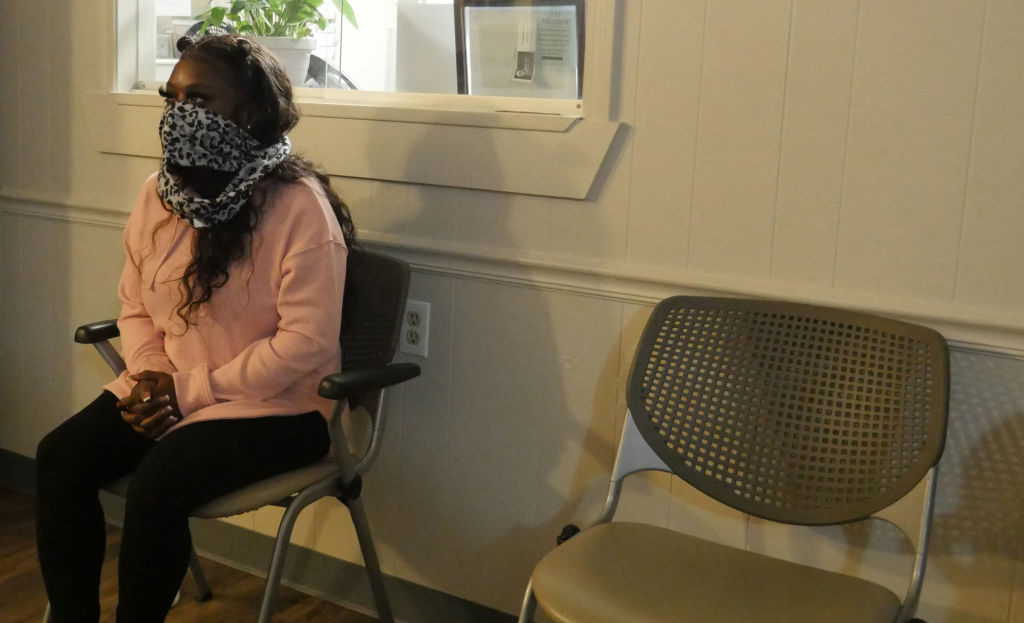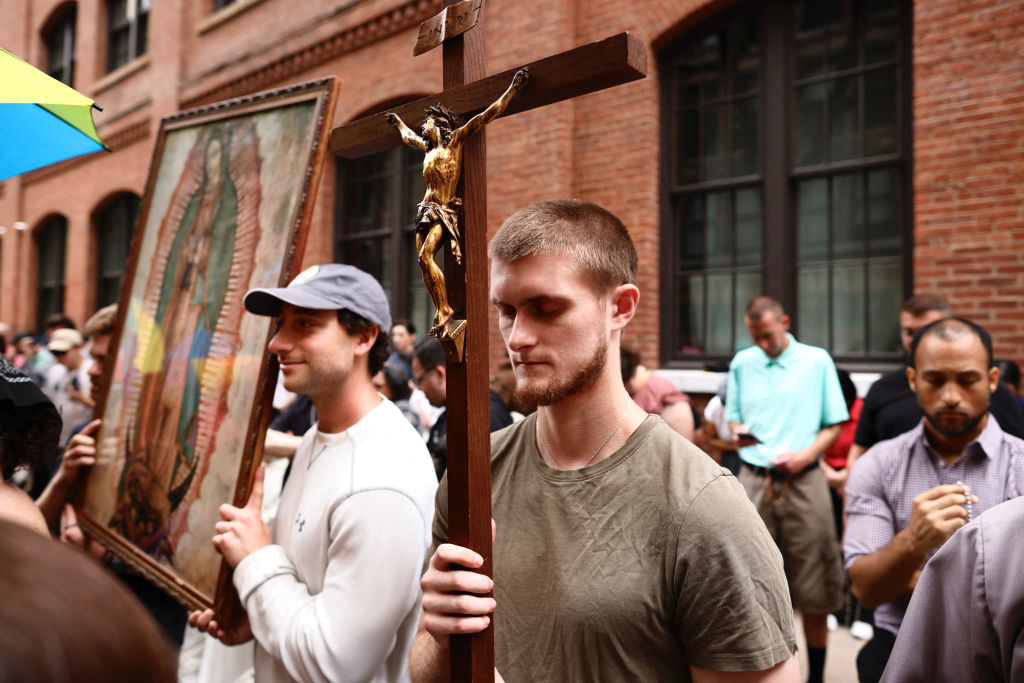At the heart of the ‘pro-life’ movement is the idea that women are put on this earth for subservience. And so this is the plan: Force women to carry pregnancies against their will.

This story originally appeared on Jill.substack.com, a newsletter from journalist, lawyer and author Jill Filipovic.
Earlier this week, an all-male panel of the Fifth Circuit Court of Appeals held that emergency rooms are not required to perform life-saving abortions for women who show up having medical emergencies. And this week in Ohio, a grand jury is deciding whether to charge Brittany Watts, a woman who went to the hospital twice for care when she was miscarrying, was sent home twice, and miscarried in her bathroom. She could face jail time for “abuse of a corpse,” because fetal parts were found clogged in her toilet.
These stories join a litany of others.
- There’s Kate Cox, whose fetus had an abnormality incompatible with life and whose pregnancy threatened her own life and health, and who went through the legal wringer in Texas only to be refused a legal, life-saving abortion.
- There’s Kristen Anaya, also pregnant with a much-wanted child, whose water broke at 15 weeks—far before a fetus can survive outside of the uterus—but was nevertheless refused an abortion in Texas; she had to go into sepsis, a deadly infection, before she could get care, and in the meantime her husband was packing her dangerously feverish body with ice packs to keep her alive. The couple is now terrified to try for another baby, and wondering just how much damage the infection and trauma did to Kristen’s body, and how much it may shorten her life.
- There’s Alyssa Gonzalez, who had to leave her home state of Alabama for a medically necessary abortion after her fetus was diagnosed with trisomy 18, a condition incompatible with life. She and her husband drove to an overrun clinic in DC, an experience that was profoundly traumatizing—instead of trying for another pregnancy, Gonzalez had a sterilization procedure. “Why on earth would she wanna risk that again?” her husband said. “Because if we were to have another child with a fetal abnormality, then we would have to go through all of this again. She barely got through it the first time.”
- There’s Anya Cook, who was 16 weeks pregnant when her water broke, but who lives in Florida, which bans abortion after 15 weeks. Instead of being offered an abortion, which could save her life, doctors sent her home with antibiotics. According to ABC News, “Cook delivered the fetus alone in the bathroom of a hair salon, hearing her daughter hit the toilet. In the process she lost a life-threatening amount of blood, became critically ill, was put on a ventilator due to blood loss and was in the hospital for six days.”
This is how dark of a moment we are in: When I read Cook’s story, I was immediately sickened, heart hurting for her and knowing that miscarrying alone in a hair salon bathroom and nearly dying from it was not how she wanted this pregnancy to end—and certainly not how she wanted to say goodbye to her child. And then I thought, “Thank god she wasn’t prosecuted.”
Because Brittany Watts, whose story is not so different from Cook’s, is being prosecuted for having a miscarriage.
Watts, 34 and living in Ohio, was almost 22 weeks pregnant when she began to miscarry. She went to the hospital for care, but couldn’t be treated quickly because a medical ethics board had to be convened to determine if she qualified for a legal abortion—since Ohio bans abortion at 22 weeks, and Watts was two days shy of the deadline. After waiting for eight hours at the hospital, she went home to process what she had been told. She returned the next day, still exhibiting symptoms of a miscarriage in progress. Again, she was not treated.
And so Watts did the only thing she could do: She went home.
If you’re squeamish, skip this and the next two paragraphs. When Watts went home, she did what many miscarrying women do: She sat on the toilet. When a person miscarries, she passes a lot of blood, clots, tissue, etc. It is bloody and messy and very often painful. Where else are you going to sit as your body excretes so much matter? And as that’s happening, what are you supposed to do, other than flush?
This of course sounds pretty grim, but again: What was her other option? Carry it to a funeral home? Women who miscarry routinely miscarry into toilets, and the embryo or fetus is then flushed. This is not a pretty reality, but it is reality, because so much of pregnancy is not pretty.
Watts went back to the hospital after the miscarriage, which was smart. Sometimes, tissue can be left behind, and that can cause serious infection. And indeed, Watts needed a dilation and curettage procedure to clear out the placenta. At some point, the hospital apparently called the city police department so that they could locate the fetus. The police went to Watts’ house, took her toilet to the morgue, broke it open, and then arrested her. She’s charged with criminal abuse of a corpse, a felony under Ohio law.
Watts, at least, lives in a state where abortion is legal up until 22 weeks, and she was reportedly at 21 weeks and five days when she miscarried. That gives her lawyers some room to argue that the fetus she miscarried wasn’t a corpse: It never took a breath, and it died in utero before Ohio’s abortion law would have made termination a crime. Watts, who is Black, is being charged anyway. And I don’t want to speculate too much, but I suspect that the people pushing to prosecute her are not exactly supporters of abortion rights.
But what about all of the women who miscarry into toilets in states where abortion is banned, or banned earlier in pregnancy? Watts’ case is a chilling preview of what could come: Miscarriage criminalized in myriad ways.
And now, the Fifth Circuit is holding that emergency rooms do not have to provide life-saving abortions—further ensuring that women with dangerous miscarriages will simply be sent home and left to manage on their own.
The Fifth Circuit decision springs from Biden administration guidance on the Emergency Medical Treatment and Active Labor Act (EMTALA) saying that emergency rooms receiving Medicaid reimbursement—which already have a legal obligation to provide the care necessary to stabilize patients in need—have to consider pregnant women as patients in need and not refuse them necessary care to stabilize them just because of any given state’s abortion law. In other words, if a pregnant woman comes into the emergency room with an acute emergency and termination is the way to stabilize her, doctors have to stabilize her and save her life. Seems reasonable enough.
Not so, say anti-abortion activists and the state of Texas, who sued over the law.
The Department of Health and Human Services (HHS), which issued the guidance, said that it hadn’t previously been necessary before the Dobbs ruling “because there wasn’t a need for it. Everybody understood that this is what was required.” Everybody understood that if a pregnant woman need an abortion to stabilize her, health workers had to give her an abortion to stabilize her. With abortion legal in all 50 states, doctors could treat life-threatening conditions (preeclampsia, ectopic pregnancy) without fearing legal reprisal.
But times have changed, the Fifth Circuit writes: “The new ingredient here is Dobbs, which caused a sea change in the law. Put simply, the Guidance sets out HHS’s legal position for the first time regarding how EMTALA operates post-Dobbs.”
The language in the Fifth Circuit decision is unnerving. They adopt a standard anti-abortion talking point, which is that health workers have to treat a pregnant women and a fetus equally as patients—the woman isn’t the patient; her care depends on what’s best for her fetus, and her well-being has to be weighed against her fetus’. If something will harm her fetus, it is generally not an option, unless she is at death’s door (and even then, it depends).
There is no room for a woman to pursue her own desires or dreams. There is only the duty to meet the needs of others, and to serve both the men who are your superiors and the children whose lives are your important than yours.
This case was brought in part by the American Association of Pro-Life Obstetricians and Gynecologists (AAPLOG), a group of fringe radicals who have linked homosexuality to pedophilia and argue that IUDs cause abortions. And here is the AAPLOG on life-saving abortions:
“Abortion is not healthcare,” said Dr. Donna Harrison, executive director of AAPLOG. “OB-GYNS are trained to preserve and protect the lives of their patients, not destroy them. Even in difficult circumstances, OB-GYNS practice compassionate, ethical care that cares for two patients—mother and child. Late-term abortions are never necessary.”
In 2013, they put a finer point on it: “As experienced practitioners and researchers in obstetrics and gynecology, we affirm that direct abortion is not medically necessary to save the life of a woman.”
The AAPLOG continued: “We uphold that there is a fundamental difference between abortion and necessary medical treatments that are carried out to save the life of the mother, even if such treatments results in the loss of life of her unborn child. We confirm that the prohibition of abortion does not affect, in any way, the availability of optimal care to pregnant women.”
Anti-abortion and Catholic groups call this the “double effect,” and I am going to really simplify it, but it essentially says that you can’t do something that is directly immoral (like end a pregnancy), but if it is absolutely necessary and there is no other way, you can do something that has the same outcome, provided you still don’t do a morally wrong thing.
The classic debate in “pro-life” circles is ectopic pregnancy. These pregnancies occur outside of the uterus, usually in a fallopian tube, and can never come to fruition—but they can kill a woman if they go untreated. In secular healthcare settings, the answer is simple: A shot of methotrexate into the embryo, which is minimally invasive and dissolves it safely without compromising the woman’s future fertility. But! That is, in a “pro-life” framework, arguably a bad act (and to be clear, there is much argument over this): It is a direct action taken to end the life of the embryo. The other option is to remove all or part of a woman’s fallopian tube, which is more invasive, more dangerous, and obviously compromises her fertility—but then, oops, the embryo dies as a side effect. The side effect was, of course, the entire point, but it’s not a direct killing so it’s fine. The AAPLOG puts it this way:
Actions leading to undesirable secondary effects, even if anticipated, can be permissible when all of the following criteria are met:
1. The primary act must be inherently good, or at least morally neutral.
2. The good effect must not be obtained by means of the bad effect.
3. The bad effect must not be intended, only permitted.
4. There must be no other means to obtain the good effect. There must be a proportionately grave reason for permitting the bad effect.
This is the standard that the Fifth Circuit embraced in determining that emergency rooms do not have to provide life-saving abortions, pushed by a group that does not believe there is such a thing a a life-saving abortion.

To understand this position, you need to understand one thing: At the heart of the “pro-life” movement is the idea that women are put on this earth for subservience. This is a religious idea (in the U.S., rooted in Christianity) that women are obedient helpmeets for male heads of household, and all-giving caretakers of children. There is no room for a woman to pursue her own desires or dreams, no worthy woman who prioritizes herself; there is only the duty to meet the needs of others, and to serve both the men who are your superiors and the children whose lives are your important than yours.
If this is your view, then it is your duty as a woman to risk anything and everything in pregnancy—even your life. Sure, that you may die may be virtually guaranteed, along with your fetus. But as some anti-abortion doctors say, god is full of miracles, and anything could happen. The Catholic Church makes saints of women who choose to die in pregnancy and orphan their children.
And so this is the plan in the U.S.: Force women to carry pregnancies against their will. If they have medical emergencies or their fetuses have serious problems, force them to continue the pregnancies anyway—forms of physical torture. If the women die, they die—it’s a tragedy, not a man-made killing, and what kind of woman wouldn’t die to keep her child alive? If women make one wrong step—if they seek abortion care out of state, if they are given a medically-necessary abortion, even if they miscarry—the first reaction should be suspicion, and the second an attempt to criminalize their disobedience.
It has only been a year and a half since the Dobbs decision and the tsunami of anti-abortion laws it brought. The devastation has been vast and deep and personal. And the anti-abortion movement is just getting started.
Up next:
U.S. democracy is at a dangerous inflection point—from the demise of abortion rights, to a lack of pay equity and parental leave, to skyrocketing maternal mortality, and attacks on trans health. Left unchecked, these crises will lead to wider gaps in political participation and representation. For 50 years, Ms. has been forging feminist journalism—reporting, rebelling and truth-telling from the front-lines, championing the Equal Rights Amendment, and centering the stories of those most impacted. With all that’s at stake for equality, we are redoubling our commitment for the next 50 years. In turn, we need your help, Support Ms. today with a donation—any amount that is meaningful to you. For as little as $5 each month, you’ll receive the print magazine along with our e-newsletters, action alerts, and invitations to Ms. Studios events and podcasts. We are grateful for your loyalty and ferocity.





